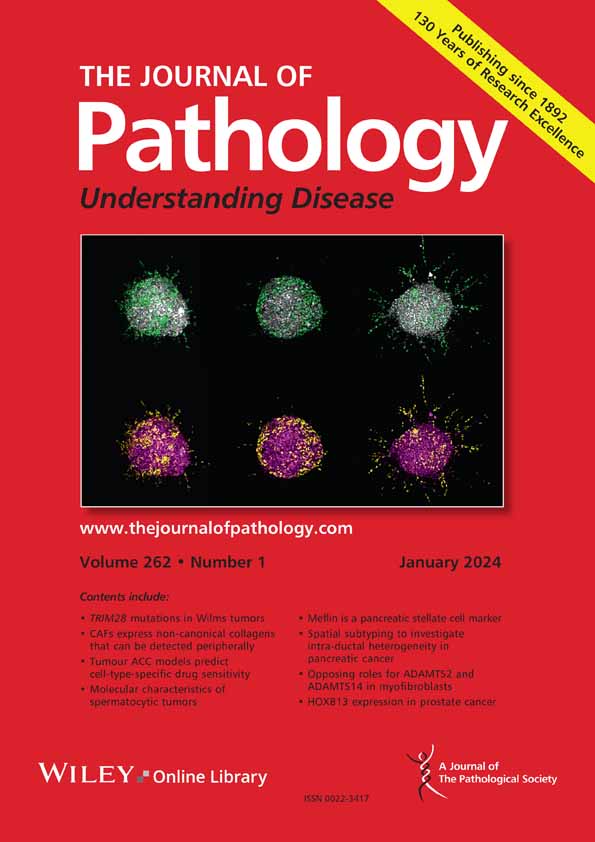Dysregulated mitochondrial energy metabolism drives the progression of mucosal field effects to invasive bladder cancer.
IF 5.2
2区 医学
Q1 ONCOLOGY
Sangkyou Lee, Sung Yun Jung, Pawel Kuś, Jolanta Bondaruk, June Goo Lee, Roman Jaksik, Nagireddy Putluri, Khanh N Dinh, David Cogdell, Huiqin Chen, Yishan Wang, Jiansong Chen, Neema Navai, Colin Dinney, Cathy Mendelsohn, David McConkey, Richard R Behringer, Charles C Guo, Peng Wei, Marek Kimmel, Bogdan Czerniak
求助PDF
{"title":"Dysregulated mitochondrial energy metabolism drives the progression of mucosal field effects to invasive bladder cancer.","authors":"Sangkyou Lee, Sung Yun Jung, Pawel Kuś, Jolanta Bondaruk, June Goo Lee, Roman Jaksik, Nagireddy Putluri, Khanh N Dinh, David Cogdell, Huiqin Chen, Yishan Wang, Jiansong Chen, Neema Navai, Colin Dinney, Cathy Mendelsohn, David McConkey, Richard R Behringer, Charles C Guo, Peng Wei, Marek Kimmel, Bogdan Czerniak","doi":"10.1002/path.6474","DOIUrl":null,"url":null,"abstract":"<p><p>Multiplatform mutational and gene expression profiling complemented with proteomic and metabolomic spatial mapping were used on the whole-organ scale to identify the molecular profile of bladder cancer evolution from field effects. Analysis of the mutational landscape identified three types of mutations, referred to as α, β, and γ. Time modeling of the mutations revealed that carcinogenesis may span 30 years and can be divided into dormant and progressive phases. The α mutations developed in the dormant phase. The progressive phase lasted 5 years and was signified by expanding β mutations, but it was driven to invasive cancer by γ mutations. The mutational landscape emerged on a background of disorganized urothelial differentiation, activated epithelial-mesenchymal transition, and enhanced immune infiltration with T-cell exhaustion. Complex dysregulation of mitochondrial energy metabolism with downregulation of oxidative phosphorylation emerged as the leading mechanism driving the progression of mucosal field effects to invasive cancer. © 2025 The Author(s). The Journal of Pathology published by John Wiley & Sons Ltd on behalf of The Pathological Society of Great Britain and Ireland.</p>","PeriodicalId":232,"journal":{"name":"The Journal of Pathology","volume":" ","pages":""},"PeriodicalIF":5.2000,"publicationDate":"2025-09-25","publicationTypes":"Journal Article","fieldsOfStudy":null,"isOpenAccess":false,"openAccessPdf":"","citationCount":"0","resultStr":null,"platform":"Semanticscholar","paperid":null,"PeriodicalName":"The Journal of Pathology","FirstCategoryId":"3","ListUrlMain":"https://doi.org/10.1002/path.6474","RegionNum":2,"RegionCategory":"医学","ArticlePicture":[],"TitleCN":null,"AbstractTextCN":null,"PMCID":null,"EPubDate":"","PubModel":"","JCR":"Q1","JCRName":"ONCOLOGY","Score":null,"Total":0}
引用次数: 0
引用
批量引用
Abstract
Multiplatform mutational and gene expression profiling complemented with proteomic and metabolomic spatial mapping were used on the whole-organ scale to identify the molecular profile of bladder cancer evolution from field effects. Analysis of the mutational landscape identified three types of mutations, referred to as α, β, and γ. Time modeling of the mutations revealed that carcinogenesis may span 30 years and can be divided into dormant and progressive phases. The α mutations developed in the dormant phase. The progressive phase lasted 5 years and was signified by expanding β mutations, but it was driven to invasive cancer by γ mutations. The mutational landscape emerged on a background of disorganized urothelial differentiation, activated epithelial-mesenchymal transition, and enhanced immune infiltration with T-cell exhaustion. Complex dysregulation of mitochondrial energy metabolism with downregulation of oxidative phosphorylation emerged as the leading mechanism driving the progression of mucosal field effects to invasive cancer. © 2025 The Author(s). The Journal of Pathology published by John Wiley & Sons Ltd on behalf of The Pathological Society of Great Britain and Ireland.
线粒体能量代谢失调驱动浸润性膀胱癌粘膜场效应的进展。
多平台突变和基因表达谱与蛋白质组学和代谢组学空间定位相结合,在全器官尺度上从场效应中确定膀胱癌进化的分子谱。突变景观分析确定了三种类型的突变,称为α, β和γ。突变的时间模型显示,癌变可能跨越30年,并可分为休眠和进展阶段。α突变发生在休眠期。进展期持续5年,以扩大的β突变为标志,但由γ突变驱动为侵袭性癌症。突变景观出现在尿路上皮分化紊乱、上皮-间质转化激活、免疫浸润增强和t细胞衰竭的背景下。线粒体能量代谢的复杂失调与氧化磷酸化的下调被认为是推动粘膜场效应向侵袭性癌症发展的主要机制。©2025作者。《病理学杂志》由John Wiley & Sons Ltd代表大不列颠和爱尔兰病理学会出版。
本文章由计算机程序翻译,如有差异,请以英文原文为准。
来源期刊
期刊介绍:
The Journal of Pathology aims to serve as a translational bridge between basic biomedical science and clinical medicine with particular emphasis on, but not restricted to, tissue based studies. The main interests of the Journal lie in publishing studies that further our understanding the pathophysiological and pathogenetic mechanisms of human disease.
The Journal of Pathology welcomes investigative studies on human tissues, in vitro and in vivo experimental studies, and investigations based on animal models with a clear relevance to human disease, including transgenic systems.
As well as original research papers, the Journal seeks to provide rapid publication in a variety of other formats, including editorials, review articles, commentaries and perspectives and other features, both contributed and solicited.

 求助内容:
求助内容: 应助结果提醒方式:
应助结果提醒方式:


